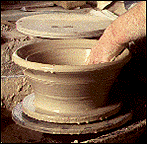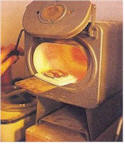Pottery at a Glance
Pottery is defined as clay that is chemically altered and
permanently hardened by firing in a kiln. The nature and type of pottery, or
ceramics (Greek keramos, “potter's clay”), is determined by the composition of
the clay and the way it is prepared; the temperature at which it is fired; and
the glazes used.
 The Potter's Wheel: invented in the 4th millennium
bc, is a flat disk that revolves horizontally on a pivot. Both hands—one on the
inside and the other on the outside of the clay—are free to shape the pot upward
from a ball of clay that is thrown and centered on the rotating wheel head. Some
wheels are set in motion by a stick that fits into a notch in the wheel (often
activated by an assistant); called a handwheel, this is the classical wheel of
Japanese potters. In 16th-century Europe, with the addition of a flywheel
separate from the wheel head and mounted in a frame, the potter could control
the wheel by kicking the flywheel. A kick bar, or foot treadle, was added in the
19th century. In the 20th century the electric wheel with a variable-speed motor
allowed greater and better regulated rotating speed.
The Potter's Wheel: invented in the 4th millennium
bc, is a flat disk that revolves horizontally on a pivot. Both hands—one on the
inside and the other on the outside of the clay—are free to shape the pot upward
from a ball of clay that is thrown and centered on the rotating wheel head. Some
wheels are set in motion by a stick that fits into a notch in the wheel (often
activated by an assistant); called a handwheel, this is the classical wheel of
Japanese potters. In 16th-century Europe, with the addition of a flywheel
separate from the wheel head and mounted in a frame, the potter could control
the wheel by kicking the flywheel. A kick bar, or foot treadle, was added in the
19th century. In the 20th century the electric wheel with a variable-speed motor
allowed greater and better regulated rotating speed.

Kiln: any of several kinds of furnace,
heated electrically or by the combustion of fuel, used to fire pottery or other
ceramic products, to roast ores, or in the production of cement. In modern
engineering usage, little distinction is made between a furnace and a kiln,
although the term kiln is always applied to the heating units used in ceramic
and cement manufacture.
Kilns in general are of two types: intermittent kilns, in which the fire must be
extinguished while the kiln is being unloaded and recharged with another batch
of material to be fired; and continuous kilns, in which loading and unloading is
accomplished while the kiln is lit. Modern kilns are of both types, although the
various forms of continuous kilns are particularly suited to mass production
manufacture. The two most important types of continuous kiln are the tunnel
kiln, in which the material heated is moved through a long combustion chamber or
heating zone on carts or conveyors, and the rotary kiln, in which the material
is moved through a long, inclined, rotating combustion chamber by the force of
gravity.
Pottery at a Glance|East
Asian Pottery|Pre
Colombian Pottery
Western
Pottery|Home
 The Potter's Wheel: invented in the 4th millennium
bc, is a flat disk that revolves horizontally on a pivot. Both hands—one on the
inside and the other on the outside of the clay—are free to shape the pot upward
from a ball of clay that is thrown and centered on the rotating wheel head. Some
wheels are set in motion by a stick that fits into a notch in the wheel (often
activated by an assistant); called a handwheel, this is the classical wheel of
Japanese potters. In 16th-century Europe, with the addition of a flywheel
separate from the wheel head and mounted in a frame, the potter could control
the wheel by kicking the flywheel. A kick bar, or foot treadle, was added in the
19th century. In the 20th century the electric wheel with a variable-speed motor
allowed greater and better regulated rotating speed.
The Potter's Wheel: invented in the 4th millennium
bc, is a flat disk that revolves horizontally on a pivot. Both hands—one on the
inside and the other on the outside of the clay—are free to shape the pot upward
from a ball of clay that is thrown and centered on the rotating wheel head. Some
wheels are set in motion by a stick that fits into a notch in the wheel (often
activated by an assistant); called a handwheel, this is the classical wheel of
Japanese potters. In 16th-century Europe, with the addition of a flywheel
separate from the wheel head and mounted in a frame, the potter could control
the wheel by kicking the flywheel. A kick bar, or foot treadle, was added in the
19th century. In the 20th century the electric wheel with a variable-speed motor
allowed greater and better regulated rotating speed.